Cutting Edge Choices: Exploring Lawn Mower Types and Features
Imagine this: it’s a warm summer evening, and you just got home from a long day at work – now you have to pull out the mower and get your yard in tip-top shape.
What if this dreaded chore could become an enjoyable pastime?
It’s a hard thing to imagine! After all, we’re used to spending hours on a slow, bumpy mower, miserable in the sweltering sun, and thinking of everything else we’d rather be doing. On top of that, it’s not rare to finish up, look at your lawn, and heave a sigh of despair at the results.
If this describes you, you’re at the right place.
At SteveCo Power, we love to help people find the perfect mower to help them mow with comfort and pride. We believe mowing your lawn can become a source of joy with a powerful, fast, and comfortable mower.
And the best part? When you’re finished, you’ll want to invite the neighbors over to check out your manicured lawn.
That’s why we wrote this blog post, going over the different types of mowers and the different features to look for. We’ll walk you through everything step-by-step so you can make an informed decision as you purchase a new lawn mower and be confident that you have made the best purchase for your specific requirements.
Let’s get started!
Types of Mowers to Choose From
The type of mower you choose depends on your specific requirements and intentions for it. We’re talking about things like:
- How big is your lawn?
- Does it have significant slopes?
- Does it have narrow areas or is it expansive and spacious?
- Does it have a lot of corners, trees, or other obstacles to mow around?
- Are you mowing lawns as a business or just mowing your personal lawn?
Answering these questions helps you hone in on the best mower for you. But before we get too far ahead of ourselves, let’s go over the main types of lawnmowers.
Zero-Turn Mowers
Zero-Turn Mowers offer several benefits over traditional riding mowers. The most obvious benefit is that they are highly maneuverable. This is achieved through a fully hydraulic drive system, which gives them the capability to have a zero-degree turning radius.
The result?
You can turn on a dime and mow around obstacles incredibly easily.
For instance, if your property has a lot of trees, flower beds, or other lawn features that are a headache to mow around, a zero-turn mower helps you maneuver around them in no time! This makes it easier to mow tight spaces and intricate patterns, which can be difficult with a traditional lawn mower. As you might guess, this makes them the most popular choice of mowers by commercial landscapers and many homeowners.
But the benefits go beyond a zero-degree turning radius.
With their expansive decks and robust engines, zero-turn mowers are designed to mow large areas quickly and efficiently and can cover more ground in less time. Their ability to turn quickly allows you to mow with greater precision and accuracy, ensuring that every inch of your lawn is mowed evenly and neatly.
Most zero-turn mowers also offer ergonomic seating and controls, which can reduce fatigue and strain on your back and dramatically increase comfort. Zero-turn mowers are most commonly used by commercial landscapers, but you can also find zero-turn models specifically designed for residential use.
Regardless of what you need it for, there are zero-turn mowers on the market to match your budget and requirements.

Stand-on Mowers
If you’re a commercial landscaper and don’t like sitting all day, or if you’re a homeowner and don’t like sitting down more than you need to, a stand-on mower might be exactly what you need!
Stand-on mowers have many of the same features and benefits as a zero-turn mower, including a zero-degree turning radius, but they are designed with a platform to stand on instead of sitting down as you do on a zero-turn mower or traditional riding mower. They’re highly maneuverable and are popular with landscapers for their increased efficiency and ease on your body.
Stand-on mowers also offer improved visibility, giving the operator a better view of the mowing area, which can help improve safety and accuracy. They also have better weight distribution and a lower center of gravity than riding mowers, giving them improved traction and stability on hills and uneven terrain.
Their compact size makes it even easier to maneuver around tight spaces and obstacles, giving them an edge over any other riding mower on the market, even zero-turn mowers. Stand-on mowers are very popular among commercial landscapers and homeowners with big yards.
Commercial Walk-behind Mowers
Commercial walk-behind mowers are another popular choice for landscapers and homeowners with big yards. They are similar to stand-on mowers, but as the name suggests, they are designed to walk behind rather than ride on them.
With all the controls at your fingertips and a smaller footprint, commercial walk-behind mowers are ideal for tight areas and mowing around obstacles and on hills and uneven terrain. Like the zero-turn and stand-on mowers, commercial walk-behind mowers have a zero-degree turning radius. Since you don’t ride on a commercial walk-behind mower, the operator naturally has an increased awareness of the surroundings and terrain.
Lawn Tractors
Lawn Tractors, also known as riding tractors, garden tractors, or front or rear-engine mowers, are the most common type of riding lawn mower.
Most Lawn tractors feature a hydrostatic transmission and a regular steering wheel, which makes them less maneuverable than zero-turn mowers. However, due to their basic design, they usually cost less than other riding mowers, making them a popular choice for homeowners with smaller lawns and tight budgets.
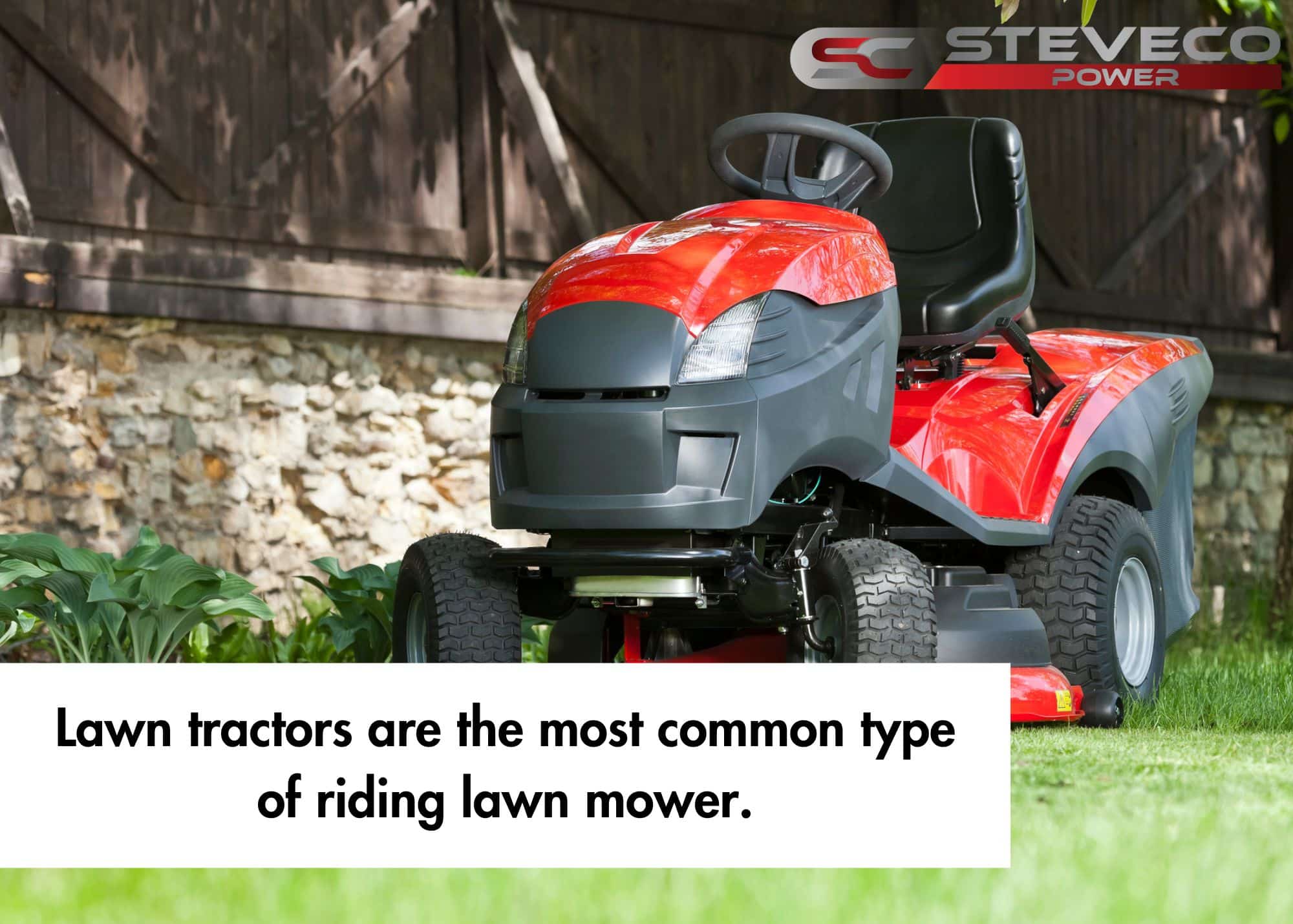
Residential Walk-Behind Mowers
Due to their convenient and easy-to-use features, residential walk-behind mowers, also known as power mowers or push mowers, are by far the most popular mowers on the market.
They are more maneuverable than riding lawnmowers or commercial walk-behind mowers and easily mow in tight spaces or around defined edges. They come with multiple features, including an engine that propels the blade, giving your lawn a pristine cut.
Most power mowers come with the option to conveniently alternate between three options for your grass clippings.
- You can choose to have the clippings discharged from the side of the deck and distributed throughout your lawn.
- If you don’t want grass clippings ending up in places like flower beds, patios, or walks, you can choose to mulch your grass clippings. In this case, the mower blade thoroughly cuts up the grass clippings and lays them straight back down on the lawn.
- You can also conveniently bag the grass so no clippings remain on your lawn.
While some power mowers need to be manually pushed, the majority have a self-propelled feature, where all you need to do is pull a lever, and the mower drives itself forward. Although they’re less affordable than reel mowers, walk-behind mowers are still budget-friendly.
But wait – what exactly is a reel mower? Let’s find out!
Reel Mowers
Reel mowers are small, simple mowers that you push across the grass. They don’t have an engine—instead, the blades are connected to a reel that rotates as you push the mower forward.
Reel mowers are popular for small lawns because they’re quiet, budget-friendly, and eco-friendly. They also allow you to do more precise mowing in places such as the edge of your flower bed.
On the other hand, reel mowers are slow and require lots of physical effort compared to other options. If you opt for a reel mower, make sure it rolls smoothly and has sharp blades, or else mowing will be quite a chore!
Cutting Options For Your Mower
Lawn mowers are small, but amazing machines. There’s quite a lot going on that we never see or are even aware of.
For example, all most people care about is that their lawn mower cuts grass properly. However, there are actually many different cutting options available for lawn mowers, each with its own set of pros and cons.
Let’s take a look so you can become an expert and understand exactly what the best cutting option for your situation and preferences is.
To get started, here are the main cutting options that are available:
- Rear Discharge Decks
- Side Discharge Decks
- Mulching Kits
- Bagger Systems
Let’s take a look at each!
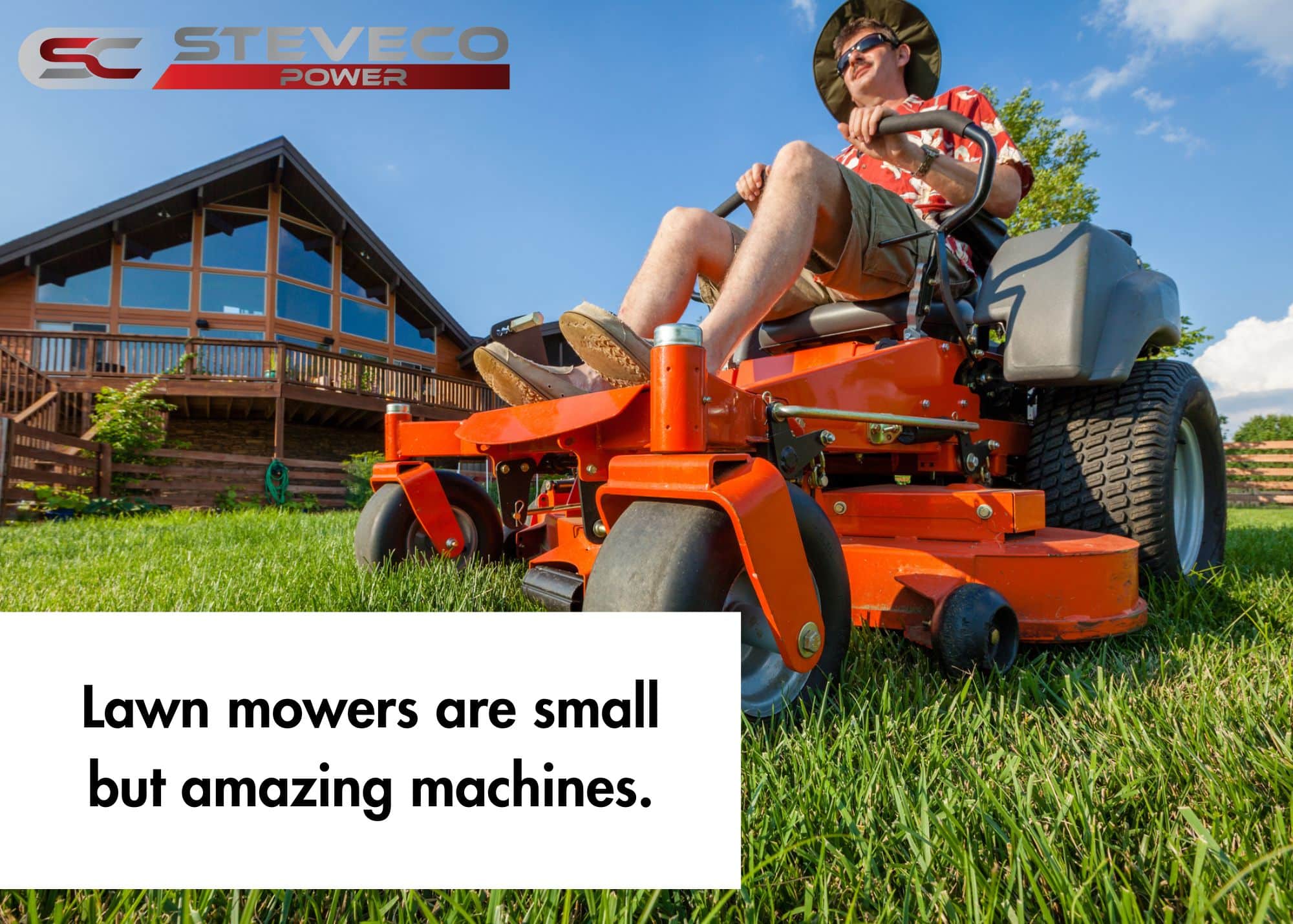
Rear Discharge Decks
Rear discharge decks are used on most small residential walk-behind mowers. While they are available on large-area and ride-on mowers, they are relatively uncommon for larger mowers and typically aren’t available for every model. If they are available for larger models, they usually cost more than the same mower equipped with a side discharge deck.
Rear discharge decks are a type of cutting deck that discharges grass clippings out of the rear of the deck, using high-lift or mulching blades rotating at high speeds underneath the deck, cutting the grass as it passes over it. As the grass is cut, it is lifted up and carried along the inside of the deck until it reaches the rear, where it is discharged through an opening.
Rear discharge decks are particularly useful in areas where the clippings need to be left on the ground, such as when mulching, as they distribute the clippings evenly across the lawn. They may also be preferred in areas with a lot of debris, as the rear discharge helps prevent clogging and buildup under the deck.
A rear discharge deck on a mower has several benefits, including:
- A deeper cutting chamber reduces clumping. The rear discharge design also allows for a more even distribution of clippings, reducing the likelihood of leaving behind unsightly clumps of grass on your lawn.
- Rear discharge decks are often more maneuverable than side discharge decks because they do not require as much clearance space on the sides of the mower.
- They typically discharge clippings in a more controlled manner, preventing the clippings from being blown into unwanted areas such as flower beds or driveways.
Overall, a rear discharge deck can provide several benefits for homeowners looking to maintain a healthy, beautiful lawn. Still, they aren’t as versatile as a side discharge deck since they don’t have the option to attach a bagger system.
Side Discharge Decks
A side discharge deck is the most common type of deck for any large area or riding mower. Side discharge decks work by using high-lift blades to cut the grass and then directing the cut grass clippings out of the side of the deck and onto the lawn.
The blades on the mower rotate at high speeds underneath the deck, cutting the grass as the mower passes over it. As the grass is cut, it is lifted up and carried along the inside of the deck until it is discharged through an opening in the side of the deck.
Side discharge decks allow for faster mowing because they can handle larger volumes of grass clippings than other types of mower decks, allowing you to cover more ground in less time. They are also less likely to clog and accumulate grass clippings than other types of mower decks, such as mulching or bagging decks, which reduces maintenance. This is because the grass clippings are discharged out through a relatively large opening in the side of the mower deck rather than being forced through a smaller opening.
Side discharge decks are generally less expensive than other types of mower decks, such as mulching, bagging, or rear discharge decks. This makes them a cost-effective option for homeowners who want to maintain their lawns without breaking the bank.
They are very versatile, allowing you to install or attach a mulching kit or a bagging system at any given time if you want to opt away from the side discharge option. Overall, a side discharge deck is a good option for homeowners who want a fast and efficient way to maintain their lawns without the added expense and maintenance associated with other types of mower decks.
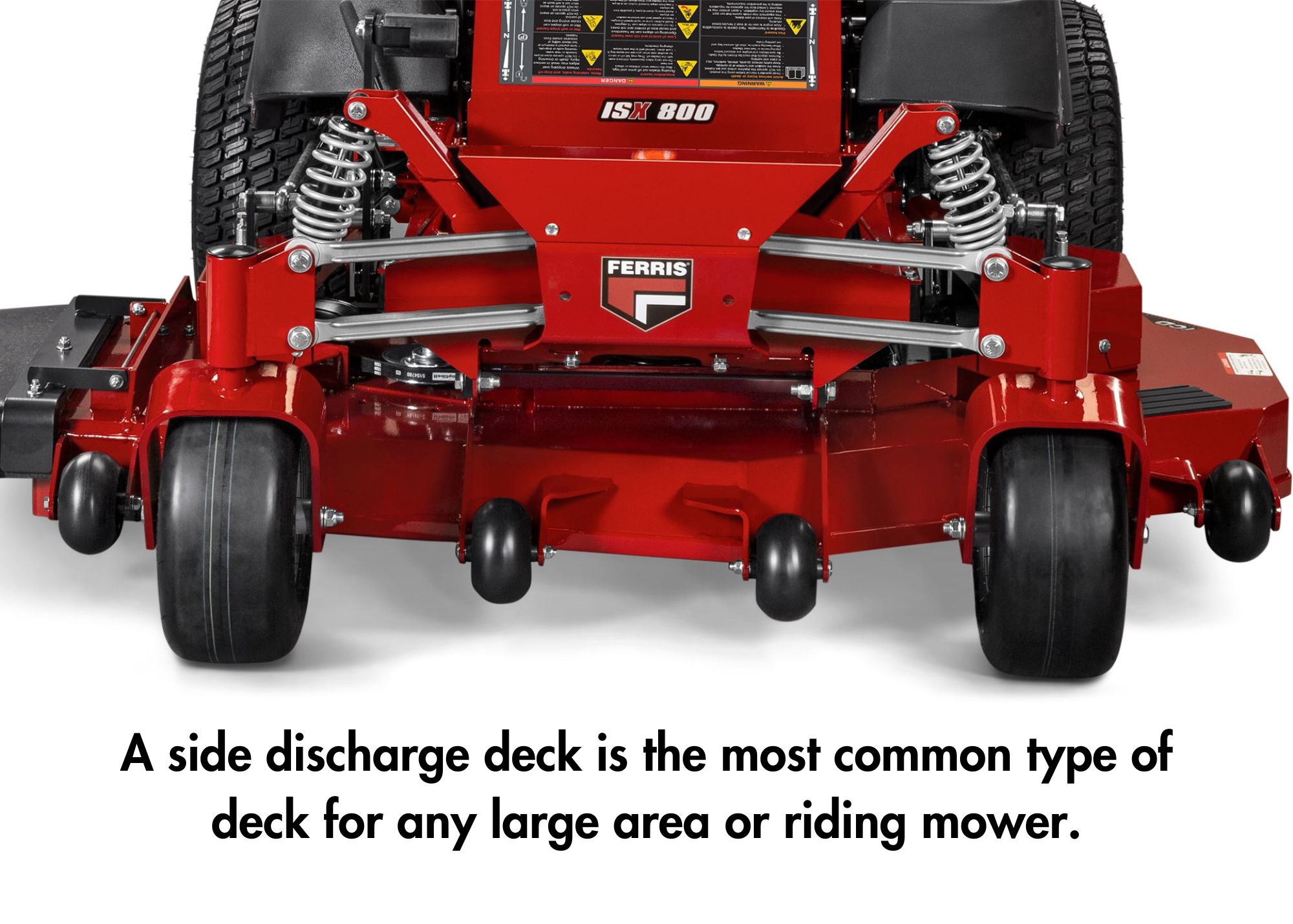
Mulching Kits
If your mower is equipped with a side discharge deck, but you don’t want grass clippings flying everywhere but still want to take advantage of the natural fertilization that the clippings provide, consider installing a mulching kit on your mower deck.
A mulching kit on a mower is designed to finely chop grass clippings and leaves into small pieces and then disperse them straight back down onto the lawn, providing natural fertilization and reducing the need for bagging or disposal of the clippings.
The kit usually consists of special mulching blades and a set of baffles that attach to the bottom of the mower deck. The mulching blades have a unique design that creates a powerful suction to lift the grass up and cut it into small pieces. The baffles help to keep the grass clippings and leaves circulating under the deck, allowing the blade to chop them into even smaller pieces. Once the grass and leaves are finely chopped, they are dispersed back onto the lawn.
The small pieces of grass and leaves eventually break down and release nutrients back into the soil, acting as a natural fertilizer for the lawn. This can help reduce the amount of fertilizer needed over time and the amount of waste generated by the mower.
Overall, a mulching kit on a mower can help to promote a healthy lawn while reducing the time and effort required for maintenance. However, it is important to note that the kit may not be suitable for all types of grass or lawn conditions, so if you have any questions about what might be best for your lawn, contact one of our professionals here at SteveCo Power for instructions and recommendations before installing and using the kit.
Bagger Systems
A bagger system on a lawn mower typically consists of collection bags, usually mounted on the rear of the mower, and a chute or tube that connects the mower deck to the bags. When the mower is in operation, the blades spin and cut the grass, directing the clippings through the chute and into the collection bags.
The bags are typically made of fabric or lightweight material that allows air to circulate but keeps the clippings contained. They may only be necessary for some mowing tasks and add extra weight and complexity to your mower. However, using a bagger system on your mower has several benefits:
- A bagger system conveniently collects grass clippings and other lawn debris, preventing it from accumulating on your lawn. This helps maintain a clean and neat lawn appearance without requiring you to rake up grass clippings and other debris after mowing.
- A bagger system also ensures there aren’t too many grass clippings on your lawn. While grass clippings and leaves can benefit the soil, they can also harm the soil. An overabundance of grass clippings or leaves on your lawn can lead to thatch buildup, preventing water, air, and nutrients from reaching the roots of your grass. When grass clippings and leaves are left on the lawn, they can also provide a breeding ground for weeds. Using a bagger system removes these clippings, reducing the likelihood of weed growth.
- A bagger system can help create a more uniform appearance when mowing by collecting clippings evenly and reducing the appearance of clumps or uneven areas on your lawn. It can also be used to collect leaves and other debris in the fall, making it a versatile tool for lawn maintenance.
Five Additional Features to Look for in a Mower
Different mowers come with various features. What features should you look for in a mower?
Here are five significant features to consider other than the cutting options.
1 - Cutting Width
When choosing a lawn mower, the size of the cutting deck plays a vital role in determining the efficiency and suitability of the equipment for a specific lawn.
To be clear, both small deck mowers and large deck mowers have their unique benefits – it’s just important that you know which is best for you.
So, here's a comparison of their advantages.
Mowers with smaller decks are generally easier to navigate, especially in tight spaces, around trees, flower beds, and other obstacles. This makes them suitable for lawns with irregular shapes or with many obstacles.
Smaller mowers also take up less storage space in your garage or shed, making them a more practical choice if you have limited storage space. They also typically cost less upfront, making them a more budget-friendly option.
Beyond that, smaller mowers are usually lighter, which makes them easier to push and handle, especially on uneven terrain or slopes. A smaller deck also means fewer components and potentially lower maintenance costs.
On the other hand, mowers with bigger decks might be more challenging to navigate, but if you have a spacious lawn, a larger deck will significantly reduce the time and effort required to mow it. Mowers with larger decks generally have more powerful engines, allowing them to handle thicker grass and more challenging terrain with greater ease.
Larger mowers are often built with more robust components to handle the extra workload, which can result in increased durability and a longer lifespan.
In summary, choosing between a small and large deck mower depends on your lawn size, storage space, budget, and personal preferences. A small deck mower is ideal for small to medium-sized lawns with obstacles and limited storage space. In contrast, a large deck mower is more suitable for more extensive lawns or properties where speed and efficiency are a priority.
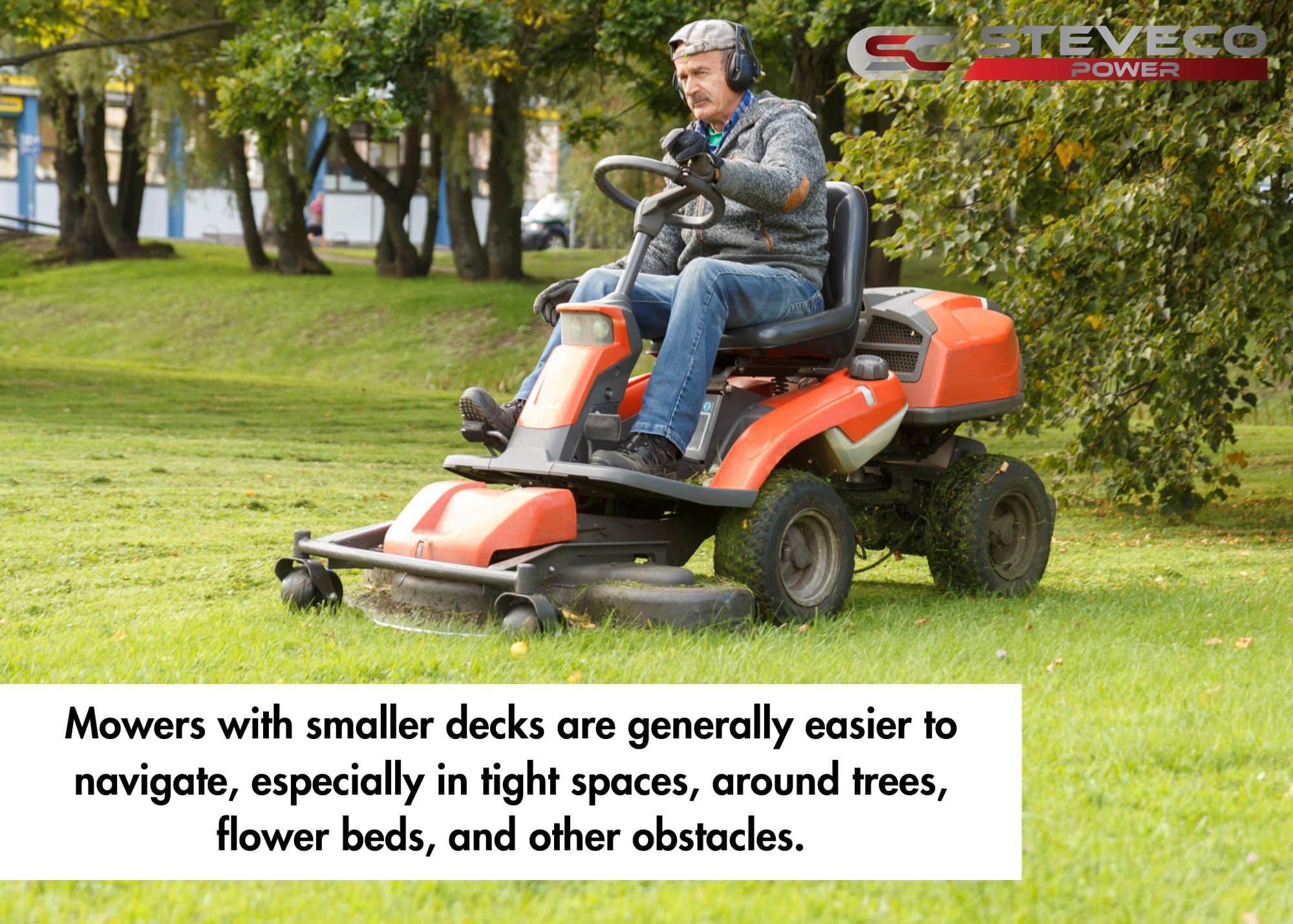
2 - Cutting Height Adjustments
All mowers have an adjustable cutting height, but some are easier to adjust than others. Sometimes you might want to trim your grass lower so you don’t have to mow as often, while other times, you might want a longer cutting length to promote healthy, lush growth. If you want to cut your grass at various heights, look for a mower that allows you to adjust the deck conveniently.
3 - Power Source: Gas or Battery
Both gas and battery-powered mowers have advantages and disadvantages. However, here are a few things to consider when debating between gas and battery-powered mowers.
Gas mowers typically have more power and can handle more demanding jobs, such as cutting through thick, tall grass. However, battery-powered technology has improved with leaps and bounds over the past few years, increasing its ability to handle tougher jobs.
With a gas mower, as long as you have enough fuel, you don't have to worry about running out of power in the middle of your job, unlike battery mowers, which require charging time between jobs and can only be used for a certain amount of time before the battery needs to be recharged.
However, you can always buy additional spare batteries to keep you working while your other batteries recharge. Typically, a battery takes less time to recharge than it does to drain, so by the time one of your batteries is drained, another battery should be ready to go.
Gas mowers require significantly more maintenance than battery mowers, including regular oil changes, air filters, and spark plug replacements. Battery mowers eliminate engine maintenance and the problems that can come with belts and cables. Gas mowers are generally louder than battery mowers and may cause noise pollution, which can be a problem in residential areas. Battery equipment operates with minimal noise, so not only will you enjoy using it, but your next-door neighbors will also applaud your choice of equipment.
Battery equipment is much easier to start and operate than gas-powered equipment. They don’t require pulling any cords or fuel priming and activate at the touch of a button. They are also typically lighter and run with reduced vibration, making the equipment nicer to handle for people of all ages and physical abilities and reducing operator fatigue.
Choosing between a gas and a battery mower depends on your specific needs and preferences. If you have a large lawn requiring frequent mowing and don't mind the maintenance and environmental impact, a gas mower may be the better choice. However, a battery mower may be better if you have a smaller lawn and want a quieter, more environmentally friendly option.
4 - Self-propelled versus Push Mowers
As we mentioned, if you buy a small residential walk-behind mower, consider one that’s self-propelled if you have a more extensive lawn or pushing the mower exhausts you.
5 - Ease of Use
Finally, many mowers have ergonomic features such as adjustable handles, comfortable grips, easy-start systems, and user-friendly controls. Trust me—when you invest in a comfortable user experience, your lawn will look much nicer, and you’ll no longer dread the task of mowing!
Finding a Local Lawn Mower Dealership
Now that you’ve done your research, you probably have a good idea of what kind of mower you’d like to buy.
Now what?
Now it’s time to head to your local lawn mower dealership!
While it may be tempting to buy your mower online or at a big box store, the experts at your local dealership will be able to answer all your questions, bring up considerations you haven’t thought of, and help you find the mower that’s right for your lawn and budget.
Not only that, but a mower is an investment. When you run into problems or need repairs, you want to have a relationship with an expert you can rely on. You can get that prompt, personalized service by working with a local dealership.
If you live in southeast Pennsylvania, in Lancaster or Chester Counties, stop in at Steveco Power for all your outdoor power equipment needs!
We offer:
Call or text us today, or stop in and see us! We look forward to helping you.
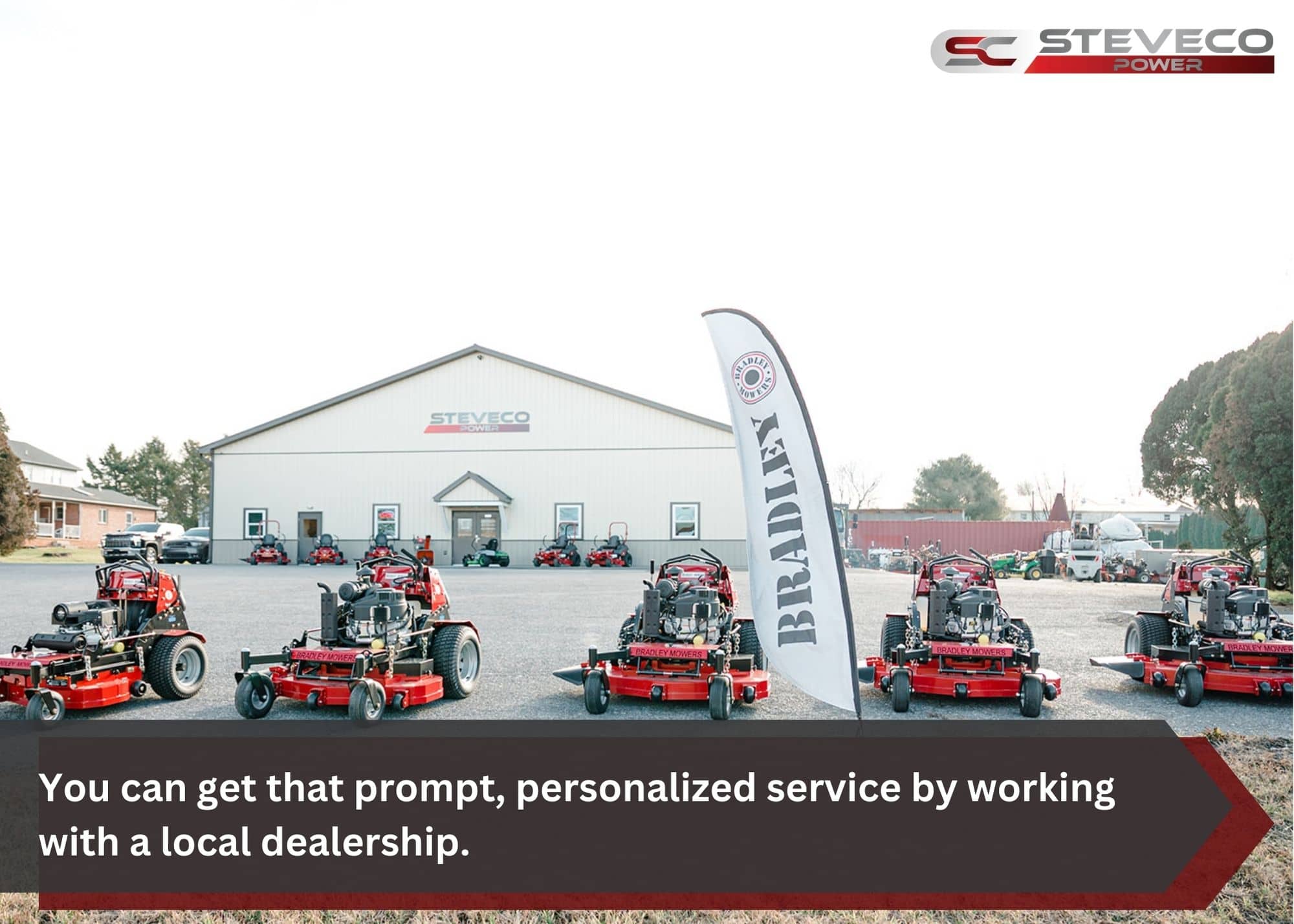





Great post! 🌟 I never knew there were so many lawn mower options. Zero-turn mowers sound perfect for maneuvering around obstacles, and stand-on mowers seem ideal for those who prefer standing. The breakdown of cutting options, like mulching kits and bagger systems, was super helpful. Thanks, SteveCo Power, for making lawn care sound fun and helping us choose the best mower! 🌿🚜